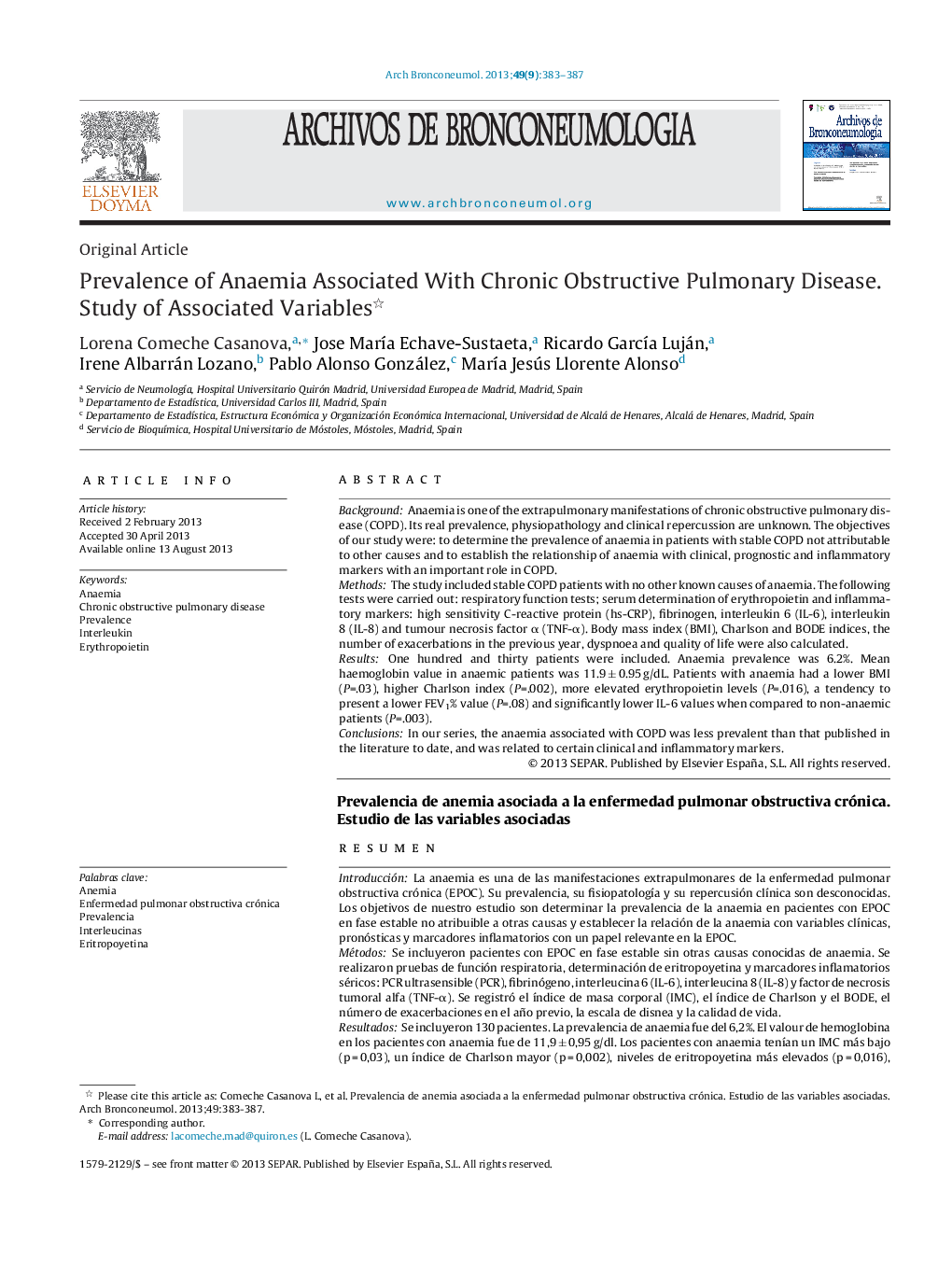| Article ID | Journal | Published Year | Pages | File Type |
|---|---|---|---|---|
| 4205657 | Archivos de Bronconeumología (English Edition) | 2013 | 5 Pages |
BackgroundAnaemia is one of the extrapulmonary manifestations of chronic obstructive pulmonary disease (COPD). Its real prevalence, physiopathology and clinical repercussion are unknown. The objectives of our study were: to determine the prevalence of anaemia in patients with stable COPD not attributable to other causes and to establish the relationship of anaemia with clinical, prognostic and inflammatory markers with an important role in COPD.MethodsThe study included stable COPD patients with no other known causes of anaemia. The following tests were carried out: respiratory function tests; serum determination of erythropoietin and inflammatory markers: high sensitivity C-reactive protein (hs-CRP), fibrinogen, interleukin 6 (IL-6), interleukin 8 (IL-8) and tumour necrosis factor α (TNF-α). Body mass index (BMI), Charlson and BODE indices, the number of exacerbations in the previous year, dyspnoea and quality of life were also calculated.ResultsOne hundred and thirty patients were included. Anaemia prevalence was 6.2%. Mean haemoglobin value in anaemic patients was 11.9 ± 0.95 g/dL. Patients with anaemia had a lower BMI (P=.03), higher Charlson index (P=.002), more elevated erythropoietin levels (P=.016), a tendency to present a lower FEV1% value (P=.08) and significantly lower IL-6 values when compared to non-anaemic patients (P=.003).ConclusionsIn our series, the anaemia associated with COPD was less prevalent than that published in the literature to date, and was related to certain clinical and inflammatory markers.
ResumenIntroducciónLa anaemia es una de las manifestaciones extrapulmonares de la enfermedad pulmonar obstructiva crónica (EPOC). Su prevalencia, su fisiopatología y su repercusión clínica son desconocidas. Los objetivos de nuestro estudio son determinar la prevalencia de la anaemia en pacientes con EPOC en fase estable no atribuible a otras causas y establecer la relación de la anaemia con variables clínicas, pronósticas y marcadores inflamatorios con un papel relevante en la EPOC.MétodosSe incluyeron pacientes con EPOC en fase estable sin otras causas conocidas de anaemia. Se realizaron pruebas de función respiratoria, determinación de eritropoyetina y marcadores inflamatorios séricos: PCR ultrasensible (PCR), fibrinógeno, interleucina 6 (IL-6), interleucina 8 (IL-8) y factor de necrosis tumoral alfa (TNF-α). Se registró el índice de masa corporal (IMC), el índice de Charlson y el BODE, el número de exacerbaciones en el año previo, la escala de disnea y la calidad de vida.ResultadosSe incluyeron 130 pacientes. La prevalencia de anaemia fue del 6,2%. El valour de hemoglobina en los pacientes con anaemia fue de 11,9 ± 0,95 g/dl. Los pacientes con anaemia tenían un IMC más bajo (p = 0,03), un índice de Charlson mayor (p = 0,002), niveles de eritropoyetina más elevados (p = 0,016), una tendencia a presentar niveles más bajos de FEV1% (p = 0,08) y valores significativamente más bajos de IL-6 (p = 0,003) cuando se comparan con los pacientes no anémicos.ConclusionesEn nuestra serie, la anaemia asociada a la EPOC es menos prevalente de lo publicado hasta la actualidad y guarda relación con determinados factores clínicos y marcadores inflamatorios.
